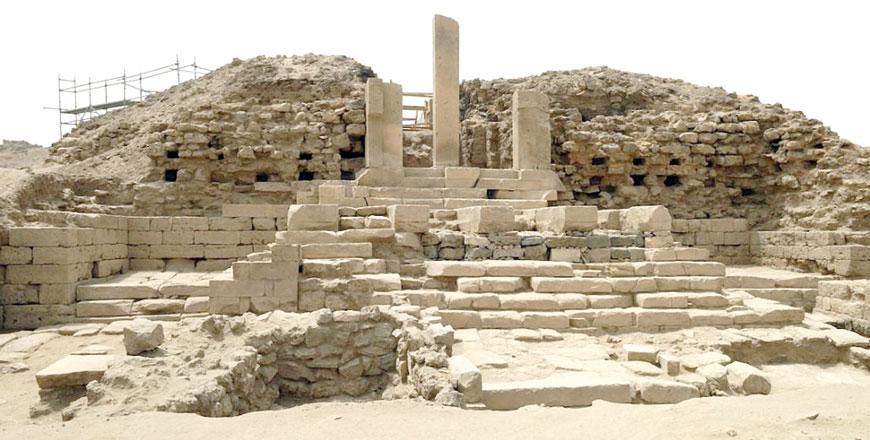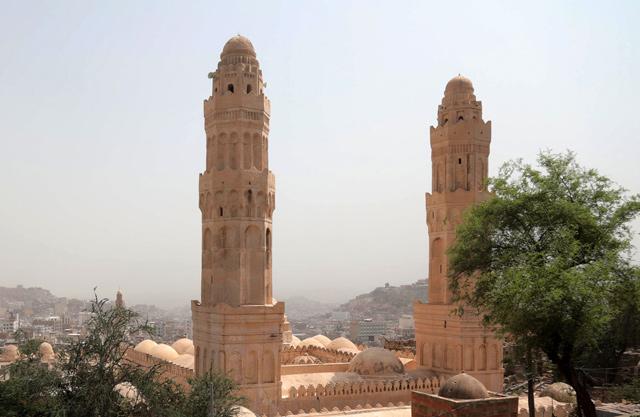You are here
'Preserving Yemeni rich heritage is task of whole int'l community'
By Saeb Rawashdeh - May 06,2018 - Last updated at May 07,2018

The entrance to a temple from the 7th century BC that was discovered by German archaeologists in Sirwah, Yemen, in May 2008 (Photo courtesy of Irmgard Wagner)
AMMAN — The destruction of cultural heritage and historical sites is one of the region's main challenges, according to Professor Emeritus Muawiyah Ibrahim, who recently delivered a lecture titled “Architectural Heritage of Yemen and the Effect of the Current War”.
Held at the Friends of Archaeology and Heritage society, the event attracted an audience of scholars and heritage lovers, including Sharifa Nofa Bint Nasser and Minister of Tourism and Antiquities Lina Annab.
Ibrahim, who used to be the Jordanian representative at UNESCO, spoke about the most well-known sites in Yemen, stressing that “he never believed in borders and, instead, jumped over them”.
In 1977, he led an international team of scholars to Timna and Marib, two ancient towns on the trade route between the south of the Arabian Peninsula and the Levant. “From the very beginning I was impressed with the Yemeni heritage," Ibrahim said, adding that the first Africans came to the Arabian Peninsula via Yemen as the country was the centre of commerce in ancient times.
Compared with other parts of the peninsula, Yemen is relatively populous, and recent research showed that Omani population migrated to modern day Yemen, the expert pointed out.
The kingdom of Awsan (southwestern Arabia) was the first Arab state, dating back to 13-12 centuries BC. As time moved closer to the early Islam period, the region came under political influence of the Sassanian Empire, Ibrahim continued, citing some 20 churches that were excavated from that interlude period.
One of characteristics of the Yemeni heritage is the mud-brick architecture and the craft which enabled Yemenis to erect 13-storey buildings or “ancient skyscrapers”, Ibrahim underlined.
Four UN World Heritage sites are present in Yemen including Sanaa’s Old City, Zabid, Shiban and Socotra Island, he said, noting that many archaeological locations are not on the list.
"I established contacts with Yemeni scholars and foreign missions," Ibrahim elaborated, outlining 61 sites with a different percentage of destruction. One of the historical monuments affected by the ongoing conflict is Imam Hadi Mosque, which was built in Sa'ada in 897.
Kawkaban, a town on the northwestern part of the country has also been exposed to systematic bombardment and the old citadel was heavily damaged, he continued, adding that "even before the war, some sites were subject to bulldozing and looting".
For Ibrahim, one of the engineering wonders of the ancient world is the Marib Dam, constructed in the 8th century BC in the valley of Dhana in the Balaq Hills.
He also referred to the town of Sirwah, saying "The strong cultural and commercial connections between the Nabataen Kingdom and south Arabian states are proved by remains of pottery and inscriptions".
In Sirwah, archaeologist from the German Archaeological Institute have found and salvaged an inscription that is longer than seven metres, "providing abundance of information on state affairs, religious beliefs and trade" the veteran archaeologist underscored.
He called on the whole international academic community and local stakeholders to protect and conserve the rich Yemeni heritage and to "initiate urgent action before the sites are destroyed beyond recognition".
Related Articles
AMMAN — Inscriptions found in Yemen and Oman dating back to the Nabataean period point to the prevalence of frankincense trade between south
PARIS — The United Nations on Wednesday inscribed an ancient city and its dam in war-torn Yemen and a futurist park in cash-strapped Lebanon
TAEZ, Yemen — The two facades of the National Museum in the Yemeni city of Taez bear testament to the ravages of a war that has consumed the



















